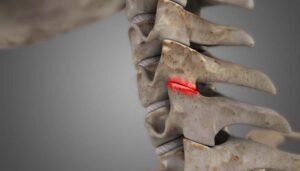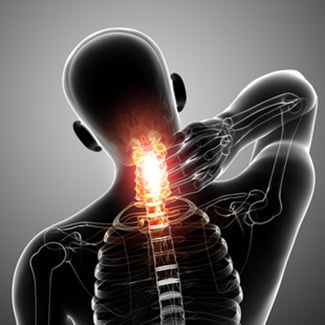Cervical Facet Syndrome is a condition often lurking in the shadows of back and neck pain discussions. This syndrome, stemming from one of the most intricate structures in our body – the spine – can significantly impact the quality of life for those who experience it. In this blog post, we will delve into the Cervical Facet Syndrome, starting from its root, causes, and symptoms associated with this condition. Further, we will provide some everyday tips and strategies to help you maintain your physical and emotional well-being.
Contents
What Is Cervical Facet Syndrome?
 Cervical Facet Syndrome is a condition that affects the small joints, called facet joints, in your neck (the cervical spine). Each vertebra in your spine has a pair of these facet joints. This provides stability and allows for a controlled range of motion. When these joints get inflamed, damaged, or experience wear and tear due to age or injury, it can result in pain, stiffness, and a restricted range of motion in the neck.
Cervical Facet Syndrome is a condition that affects the small joints, called facet joints, in your neck (the cervical spine). Each vertebra in your spine has a pair of these facet joints. This provides stability and allows for a controlled range of motion. When these joints get inflamed, damaged, or experience wear and tear due to age or injury, it can result in pain, stiffness, and a restricted range of motion in the neck.
Some individuals may also experience headaches or pain that radiates into the shoulders or upper back. The pain and discomfort associated with this syndrome can be quite debilitating and can significantly interfere with a person’s daily activities. However, with the right diagnosis and treatment, it is possible to manage these symptoms and improve the quality of life.
What Are The Symptoms To Look For?
Cervical Facet Syndrome presents with several distinct symptoms. Here are some of the common ones:
- Neck Pain: This is often the most noticeable symptom. The pain tends to be localized to the neck and is often described as a dull ache or a sharp pain. Particularly with movement.
- Radiating Pain: Pain may radiate to surrounding areas such as the shoulders, upper back, or arms. It may also lead to headaches, particularly at the back of the head.
- Limited Range of Motion: Stiffness or difficulty moving the neck can be a significant symptom. This can be especially noticeable when trying to turn the head from side to side or tilt the head backward or forward.
- Tenderness: The affected area may be tender to the touch, and this tenderness can extend to the shoulder and upper back areas.
- Grinding or Cracking Sounds: You may notice a grinding or cracking sound, also known as crepitus, when moving your neck.
- Increased Pain with Certain Activities or Postures: Pain often worsens with activities that put a strain on the neck, such as looking up or down for extended periods, heavy lifting, or prolonged sitting or standing.
These symptoms can vary from person to person in terms of their severity and frequency. If you’re experiencing persistent neck pain along with any of these other symptoms, it may be indicative of Cervical Facet Syndrome and it would be prudent to seek medical advice.
What Causes Cervical Facet Syndrome?
 Cervical Facet Syndrome is often caused by a variety of factors that put stress on the cervical facet joints, leading to degeneration, inflammation, or injury. Here are some common causes:
Cervical Facet Syndrome is often caused by a variety of factors that put stress on the cervical facet joints, leading to degeneration, inflammation, or injury. Here are some common causes:
- Aging
As we age, the cartilage in our joints naturally wears down. This degeneration can lead to osteoarthritis in the facet joints, causing pain and stiffness. This is the most common cause of Cervical Facet Syndrome.
- Trauma
Injuries to the neck, such as those sustained in a car accident or while playing sports, can damage the facet joints and lead to the syndrome.
- Poor Posture
Chronic poor posture, particularly during activities. Such as working at a computer or looking down at a smartphone, can put added stress on the facet joints.
- Repetitive Strain
Repetitive activities or occupations that require frequent neck movement or heavy lifting can contribute to wear and tear of the facet joints.
- Obesity
Being overweight or obese can put additional pressure on the spine, including the facet joints. Eventually, leading to increased wear and tear.
- Genetics
Some people may have a genetic predisposition to developing conditions like osteoarthritis. This can affect the facet joints.
It’s important to note that while these factors can increase the risk of developing Cervical Facet Syndrome, they do not guarantee its onset. Many people with these risk factors will not develop the condition. And conversely, some people without these risk factors will. It’s a complex condition with many contributing factors.
Impact Of Cervical Facet Syndrome On Daily Life
The impact of Cervical Facet Syndrome on daily life can be quite significant. And, affecting both physical function and emotional well-being.
Physical Consequences
- Limitation of Activities: People suffering from Cervical Facet Syndrome often experience pain and discomfort during routine activities. Such as driving, exercising, or even simple tasks like reading a book or using a computer. This can limit their ability to perform these tasks or may require them to modify their activities to manage the pain.
- Disturbed Sleep: The pain and discomfort can also interfere with sleep, leading to insomnia or other sleep disturbances. This lack of restorative sleep can further exacerbate symptoms and contribute to a cycle of pain and fatigue.
- Impaired Mobility: The stiffness and reduced range of motion can affect mobility and make it difficult for individuals to turn their heads. This can impact routine tasks, such as checking blind spots while driving.
Emotional and Psychological Impact

- Mental Health Challenges: Living with chronic pain can take a toll on mental health, potentially leading to conditions such as depression or anxiety. The limitations on activities and decreased quality of life can exacerbate these mental health challenges.
- Stress and Frustration: The pain and limitations can lead to increased stress and frustration. This can further exacerbate the pain, creating a vicious cycle.
- Social Impact: The symptoms of Cervical Facet Syndrome can impact social activities. This is making it harder to maintain an active social life. And, this can in turn lead to feelings of isolation or loneliness.
It’s important to note that everyone’s experience with Cervical Facet Syndrome is unique. And the impact on daily life can vary widely from person to person. However, with the right treatment plan and support, many people can manage these impacts and lead fulfilling lives.
How Is It Diagnosed?
Diagnosing Cervical Facet Syndrome typically involves a combination of medical history review, physical examination, and diagnostic tests to rule out other potential causes of neck pain. And to identify the specific involvement of the cervical facet joints. The diagnostic process may include the following steps:
- Medical History: Your healthcare provider will begin by asking you about your symptoms, and medical history. And any previous injuries or conditions that may be relevant.
- Physical Examination: A thorough physical examination will be conducted to assess your neck’s range of motion, posture, and areas of tenderness. The doctor will also look for any neurological symptoms like weakness, numbness, or abnormal reflexes.
- Imaging Tests: X-rays, CT scans, or MRI scans may be ordered to get detailed images of the cervical spine. These imaging tests can help identify any degeneration, osteoarthritis, fractures, or other abnormalities in the facet joints.
- Diagnostic Injections: Facet joint injections, also known as medial branch blocks, may be used as a diagnostic tool. An anesthetic or numbing medication is injected into the nerves that supply the facet joints. If the injection provides significant pain relief, it suggests that the facet joints are the source of the pain.
- Diagnostic Procedures: In some cases, other diagnostic procedures such as facet joint arthrography or diagnostic nerve blocks may be performed to pinpoint the exact source of the pain.
It’s crucial to have a proper diagnosis, as neck pain can have various causes, and successful treatment depends on identifying the specific underlying condition.
How To Treat Cervical Facet Syndrome?
The treatment of Cervical Facet Syndrome aims to alleviate pain, improve mobility, and enhance the individual’s overall quality of life. Here are some common treatment options:
Conservative Management
- Pain Medication: Over-the-counter pain relievers or prescription medications can help manage pain. And reduce inflammation.
- Physical Therapy: Targeted exercises and stretches can strengthen the neck muscles, improve flexibility, and enhance posture.
- Heat/Cold Therapy: Applying heat or cold packs to the affected area can help reduce pain and inflammation.
- Activity Modification: Avoiding activities that worsen the pain and adopting ergonomic practices can help minimize strain on the neck.
- Cervical Collar: Short-term use of a soft cervical collar may provide support and limit neck movement during the acute phase of pain.
Interventional Treatments
- Facet Joint Injections: These injections, containing anesthetics and steroids, can provide temporary relief by reducing inflammation. Also numbing the nerves in the facet joints.
- Medial Branch Blocks: Similar to facet joint injections, medial branch blocks target the nerves supplying the facet joints to identify the source of pain and provide short-term relief.
- Radiofrequency Ablation (RFA): RFA uses heat to destroy the nerves carrying pain signals from the facet joints. Eventually, providing longer-lasting pain relief.
Surgery
If conservative treatments and interventional procedures do not provide relief, surgery may be considered a last resort. Surgical options can include:
- Facet Joint Denervation: Involves selectively destroying the nerves supplying the facet joints using radiofrequency energy.
- Facet Joint Fusion: In severe cases, the facet joints may be surgically fused to stabilize the spine and reduce pain.
- Artificial Disc Replacement: In cases of significant facet joint degeneration, replacing the affected disc with an artificial one can help restore mobility and reduce pain.
Lifestyle Changes

- Maintaining a healthy weight reduces stress on the spine.
- Practicing good posture and ergonomics to minimize strain on the neck.
- Regular low-impact exercise to promote overall spine health.
Treatment plans should be individualized, and a combination of these approaches may be recommended based on the specific needs and responses of each patient. It’s essential to work closely with a healthcare provider to determine the most suitable treatment options.
Conclusion
In conclusion, Cervical Facet Syndrome is a challenging condition that can significantly impact a person’s daily life. Understanding its causes, symptoms, and diagnostic procedures is crucial for accurate diagnosis and effective treatment. While it can present obstacles, there is hope in various management approaches, from conservative methods to interventional treatments.
Additionally, embracing lifestyle changes and practicing good posture, can play a pivotal role in enhancing overall spine health. By empowering ourselves with knowledge and seeking appropriate medical guidance, we can navigate this condition with resilience and strive to improve our quality of life.
If you’re experiencing Back pain, physical therapy for back pain at PhysioMantra can help: Book an online physical therapy session.



